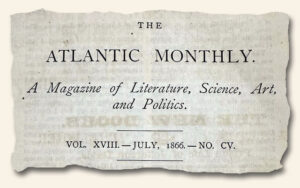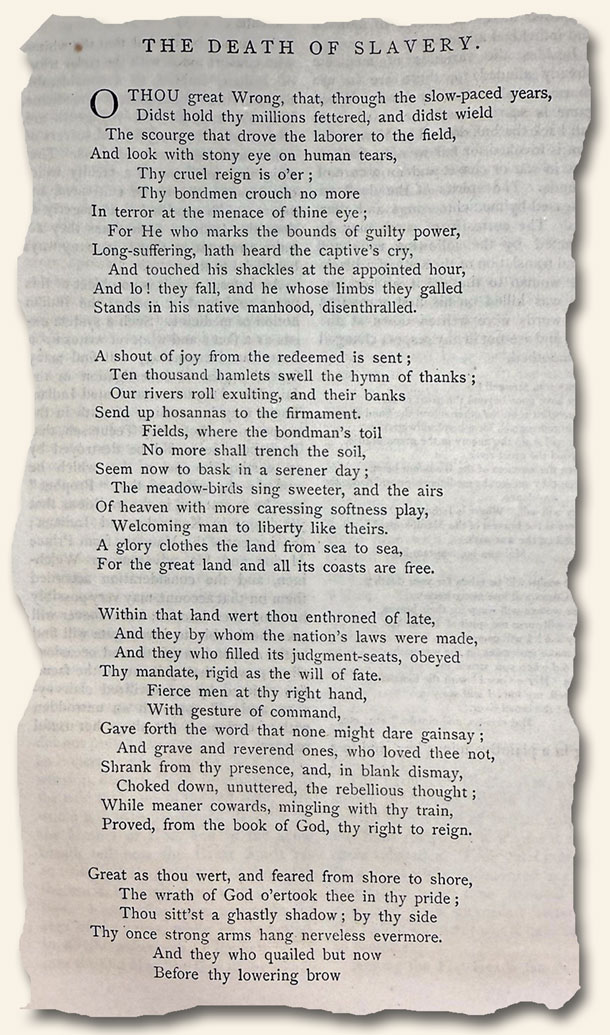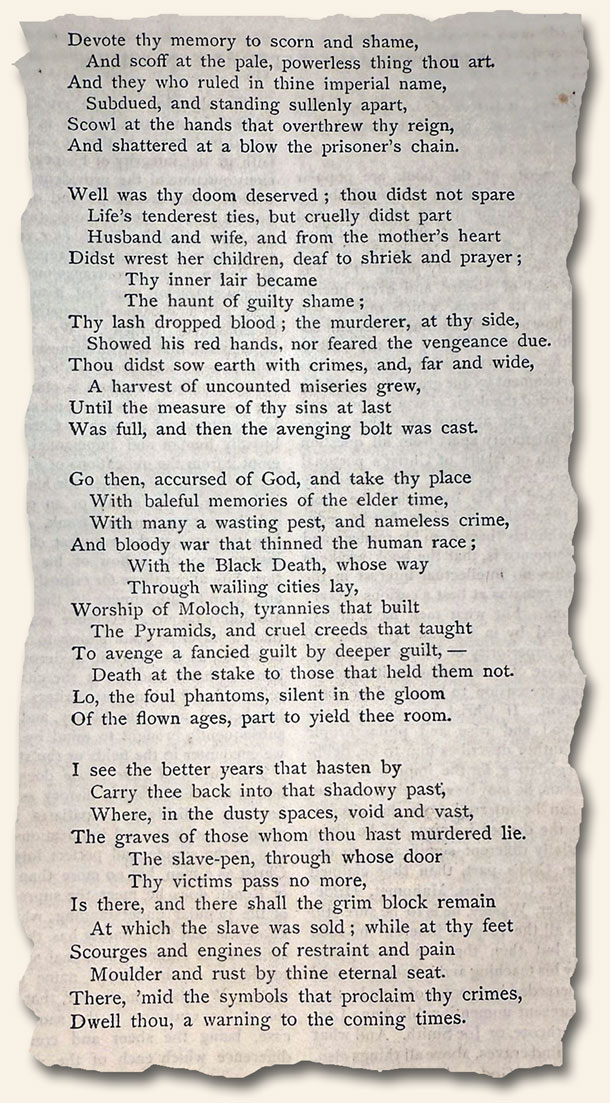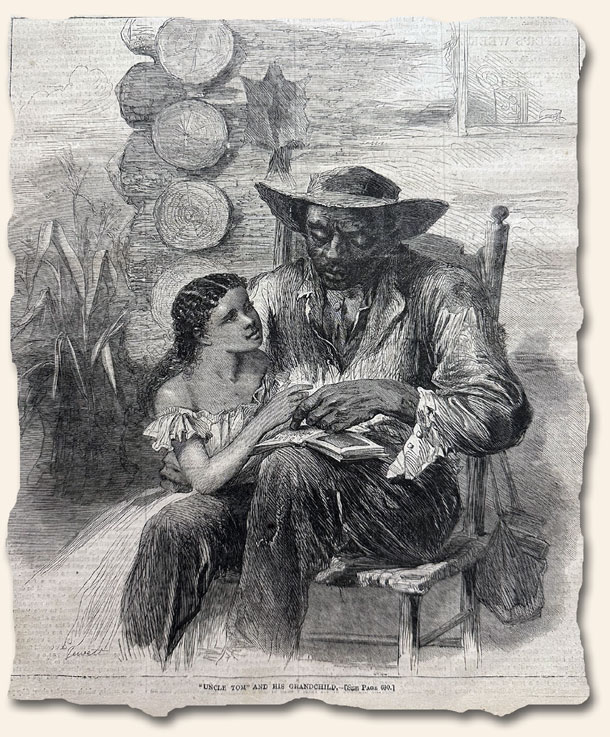Snapshot 1866 – Slavery: A Wound on the Soul of a Nation…
August 25, 2025 by GuyHeilenman · 1 Comment
 Few institutions in human history have inflicted more suffering or revealed deeper moral failings than slavery. Its cruelty was evident to many, even in its own time, and voices of conscience spoke out with clarity and passion against it.
Few institutions in human history have inflicted more suffering or revealed deeper moral failings than slavery. Its cruelty was evident to many, even in its own time, and voices of conscience spoke out with clarity and passion against it.
Frederick Douglass exposed the hypocrisy of those who justified such inhumanity in the name of religion:
“The man who wields the blood-clotted cowskin during the week fills the pulpit on Sunday, and claims to be a minister of the meek and lowly Jesus.”
Abraham Lincoln, never one to shy away from blunt truths, offered this biting reflection:
“Whenever I hear anyone arguing for slavery, I feel a strong impulse to see it tried on him personally.”
William Lloyd Garrison cut to the heart of the injustice:
“The slave is doomed to toil, that others may reap the fruits.”
And Harriet Tubman, who risked everything to lead others to freedom, distilled its evil to its core:
“Slavery is theft — theft of a life, theft of work, theft of any opportunity to shape one’s own destiny.”
While President Lincoln’s Emancipation Proclamation, issued on January 1, 1863, marked a turning point, the road to slavery’s demise was long, brutal, and soaked in the blood of those who fought to end it. The institution did not go quietly—it clung on with all its bitter force until finally it was defeated, leaving behind a scar but also a renewed hope for the American promise.
This complex and painful chapter was not lost on poet William Cullen Bryant. In 1866, just a year after the Civil War’s end, he shared his reflections in a powerful poem published in the July issue of The Atlantic Monthly. That poem, in its entirety, is presented below—a poignant reminder of what was endured, and what was overcome.

June 19, 1865 – The historical foundation of “Juneteenth”…
June 19, 2025 by GuyHeilenman · Leave a Comment
“Juneteenth”, also known as “Freedom Day”, traces its roots to June 19, 1865, when Union General Gordon Granger arrived in Galveston, Texas, and issued General Order No. 3, officially freeing the last enslaved people in the western Confederacy. Though President Lincoln’s Emancipation Proclamation went into effect on January 1, 1863, its enforcement relied on Union military presence, leaving remote areas like Texas unaware of their liberty until Granger’s announcement more than two years later.
In the years that followed, formerly enslaved communities in Texas and beyond began marking June 19th with readings of the Emancipation Proclamation, songs like “Lift Every Voice and Sing,” and family gatherings. These early observances blended solemn reflection on the horrors of slavery with joyful celebration of resilience and community, laying the groundwork for a distinctly African American holiday honoring freedom and heritage.
Though Texas led the way by making Juneteenth an official state holiday in 1980, its recognition spread gradually until June 17, 2021, when it became a federal holiday—Juneteenth National Independence Day. Today, Juneteenth invites all Americans to reflect on our nation’s delayed promise of liberty, celebrate African American culture, and renew the commitment to racial equality and justice.
Since Juneteenth’s elevation to a federal holiday in 2021, collectors have eagerly hunted for contemporary newspaper accounts of those first celebrations following General Granger’s Order. Yet, such early reports remain elusive—a notable exception being a brief item in the June 21, 1866 issue of The New York Times (shown below).
Although firsthand press coverage is scarce, that scarcity in no way diminishes the profound significance of American slavery’s end. Our nation’s work to fulfill the promise enshrined in the Declaration of Independence—“that all men are created equal” and endowed with “Life, Liberty, and the pursuit of Happiness”—remains unfinished. We must press on with unwavering resolve, viewing one another through the lens of divine dignity birthed by our Creator and allowing that vision to guide how we honor and uplift each and every person.
For those who would like to explore additional related topics through the eyes of “rare & early” newspapers, feel free to peruse the issues found through the following links:
Slavery
Emancipation
Abolition
The meanderings of those who collect Rare & Early Newspapers…
August 11, 2023 by GuyHeilenman · Leave a Comment
One of the more difficult challenges the staff at Timothy Hughes Rare & Early Newspapers face on a near-daily basis is to not be (too often) distracted by that which makes the hobby itself so interesting: that is, that one never knows what one may find while perusing an old newspaper… nor where it may lead. In other words, to not become endlessly distracted. It really is the “back in the good old days” version of surfing the web. This isn’t to say the meanderings are bad per se, for if we permit ourselves to be carried away for a period of time there is much to learn; however, if permitted to get out of hand the phone would be ringing off the hook from collectors wondering why their purchases, which will likely lead to their own meanderings, have yet to ship. Combining the old (rare newspapers) with the new (the internet) has only exacerbated the temptation.
One minor instance occurred just a few weeks ago which, if you have a few minutes to spare, I’d like to share with you.
We recently purchased a set of The National Era which included many of the original installments of the serialized printing of Uncle Tom’s Cabin by Harriet Beecher Stowe. While tagging the issues which contained segments of her profoundly culture-altering novel, we noticed several issues which did not have portions still contained related articles. This led us to do an internet search for additional titles (newspaper publications) which had Uncle Tom’s Cabin themed coverage… and this is where the fun began.
I expected the big boys (The New York Times, Tribune, and Herald, along with other notable papers such as the Philadelphia Inquirer and The Liberator) to have mentions. However, I did not expect to see coverage of the book in The Saturday Evening Post – and as fate would have it, the issue referenced was one buried deep within our archives. Off I went to find the July 29, 1865 issue. Hoping for a glorious, detailed report, what I found instead was a poem with a mere mention. Still, although a bit disappointed, I was intrigued by the first line of the article: “There are fragments of songs that nobody sings”, by B. F. Taylor. After having my curiosity piqued by the line, and my sleeping heart stirred by the article itself, I headed back to the internet to find the text of the entire poem (which turned out to be significantly more challenging – dare I say time-consuming – than expected). Once found and read, the entirety of the trek to this point caused me to sense the tension between hope and sorrow… which led me to wonder how those who lived in the mid-1800’s morphed from anger (having read Uncle Tom’s Cabin), to hopelessness (seeing little-to-no change in the state of slavery since their “forefathers” had agreed it should be abolished, but did not do so for fear that the doing so would cause their quest to become a “united” group of states to fail), to hope in a trickle… and then a stream… and then a flood… and then a bloody tidal wave called the American Civil War… to deep sorrow (for the sins of the past and deadly consequences thereof), to restored hope and wonder (in what the future might hold).
Although at this point I could hear my daily tasks calling, this mental excursion was not to be stifled for it had caused me to recall a certain illustration from the cover of the Harper’s Weekly dated November 3, 1866) – a woodcut print of which I was familiar, yet one I had never taken the time to read the blurb describing it. Not wanting to let my travels come to an end with a whimper, I read the short description – And this led me to my final question and motivation for writing this verbose post: When/how did the moniker “Uncle Tom”, born from the text which had been instrumental in vanquishing slavery, morph from being a term of endearment to a gross insult? While the road I had taken did not lead me to new “finds” within our inventory, it did awaken my heart to the plight of slavery and my mind to the understanding of why a nickname which had once been bestowed on someone with kindness and admiration had transformed into one of the greatest cultural (and political) insults aimed at black Americans. The latter I learned by one more trip to the internet: When ‘Uncle Tom’ Became an Insult
The following photos provide a visual glimpse of my meanderings, with the poem by B. F. Taylor saved for last. If you made it this far, thanks for indulging me. Please know if you decide to start collecting rare and early newspapers, this condition is highly contagious. If you already are a collector, you already know.



A December, 2016 stroll back thru time – 50, 100, 150, 200, & 250 years ago…
December 8, 2016 by GuyHeilenman · Leave a Comment
 the daily and weekly newspapers of the period can be quite revealing. This is why we often say, “History is never more fascinating than when it’s read from the day it was first reported.” The following links will take you back in time to show the available newspapers from the Rare & Early newspapers website. There’s no need to buy a thing. Simply enjoy the stroll.
the daily and weekly newspapers of the period can be quite revealing. This is why we often say, “History is never more fascinating than when it’s read from the day it was first reported.” The following links will take you back in time to show the available newspapers from the Rare & Early newspapers website. There’s no need to buy a thing. Simply enjoy the stroll.
The Traveler… “…I could see no promise in him…”
December 5, 2016 by The Traveler · Leave a Comment
Today I traveled to New York City by the means of Harper’s New Monthly Magazine dated December, 1866. I found the first appearance of Mark Twain in a national magazine with the publishing of “Forty-Three Days in an Open Boat. Compiled From Personal Diaries.”
 I also found through the Harper’s Monthly website the following information. “Mark Twain’s first article in Harper’s was miss-attributed to Mark Swain. The story, “Forty-three Days in an Open Boat” (December 1866), is an account of the Hornet, a clipper ship that caught fire in the ocean, leaving its crew adrift. Twain referred to it as the “first magazine article I ever published,” though he had published numerous pieces in other periodicals and newspapers under such names as Thomas Jefferson Snodgrass; W. Epaminondas Adrastus Blab; Rambler; Grumbler; and Peter Pencilcase’s Son, John Snooks.
I also found through the Harper’s Monthly website the following information. “Mark Twain’s first article in Harper’s was miss-attributed to Mark Swain. The story, “Forty-three Days in an Open Boat” (December 1866), is an account of the Hornet, a clipper ship that caught fire in the ocean, leaving its crew adrift. Twain referred to it as the “first magazine article I ever published,” though he had published numerous pieces in other periodicals and newspapers under such names as Thomas Jefferson Snodgrass; W. Epaminondas Adrastus Blab; Rambler; Grumbler; and Peter Pencilcase’s Son, John Snooks.
Mark Twain was born thirty-one years earlier, and two months premature, as Samuel Langhorne Clemens, in Florida, Missouri. “When I first saw him I could see no promise in him,” his mother said. The Clemenses moved several miles upstate, to the Missouri River-side Hannibal, when he was four; the town would later inspire the fictional St. Petersburg of his two most famous works, The Adventures of Tom Sawyer (1876) and The Adventures of Huckleberry Finn (1885)…”.
Twain didn’t turn out too bad after-all!
~The Traveler
A November, 2016 stroll back thru time – 50, 100, 150, 200, & 250 years ago…
November 3, 2016 by GuyHeilenman · Leave a Comment
 never more fascinating than when it’s read from the day it was first reported.” The following links will take you back in time to show the available newspapers from the Rare & Early newspapers website. There’s no need to buy a thing. Simply enjoy the stroll.
never more fascinating than when it’s read from the day it was first reported.” The following links will take you back in time to show the available newspapers from the Rare & Early newspapers website. There’s no need to buy a thing. Simply enjoy the stroll.
An October, 2016 stroll back thru time – 50, 100, 150, 200, & 250 years ago…
October 3, 2016 by GuyHeilenman · Leave a Comment
 What news was reported in the month of October – 50, 100, 150, 200, and 250 years ago (1966, 1916, 1866, 1816, 1766)? Such a walk back through time via the eyes of those who read the daily and weekly newspapers of the period can be quite revealing. This is why we often say, “History is never more fascinating than when it’s read from the day it was first reported.” The following links will take you back in time to show the available newspapers from the Rare & Early newspapers website. There’s no need to buy a thing. Simply enjoy the stroll.
What news was reported in the month of October – 50, 100, 150, 200, and 250 years ago (1966, 1916, 1866, 1816, 1766)? Such a walk back through time via the eyes of those who read the daily and weekly newspapers of the period can be quite revealing. This is why we often say, “History is never more fascinating than when it’s read from the day it was first reported.” The following links will take you back in time to show the available newspapers from the Rare & Early newspapers website. There’s no need to buy a thing. Simply enjoy the stroll.
A September, 2016 stroll back thru time – 50, 100, 150, 200, & 250 years ago…
September 1, 2016 by GuyHeilenman · Leave a Comment
 What news was reported in the month of September – 50, 100, 150, 200, and 250 years ago (1966, 1916, 1866, 1816, 1766)? Such a walk back through time via the eyes of those who read the daily and weekly newspapers of the period can be quite revealing. This is why we often say, “History is never more fascinating than when it’s read from the day it was first reported.” The following links will take you back in time to show the available newspapers from the Rare & Early newspapers website. There’s no need to buy a thing. Simply enjoy the stroll.
What news was reported in the month of September – 50, 100, 150, 200, and 250 years ago (1966, 1916, 1866, 1816, 1766)? Such a walk back through time via the eyes of those who read the daily and weekly newspapers of the period can be quite revealing. This is why we often say, “History is never more fascinating than when it’s read from the day it was first reported.” The following links will take you back in time to show the available newspapers from the Rare & Early newspapers website. There’s no need to buy a thing. Simply enjoy the stroll.
An August, 2016 stroll back thru time – 50, 100, 150, 200, & 250 years ago…
August 4, 2016 by GuyHeilenman · Leave a Comment
 What news was reported in the month of August – 50, 100, 150, 200, and 250 years ago (1966, 1916, 1866, 1816, 1766)? Such a walk back through time via the eyes of those who read the daily and weekly newspapers of the period can be quite revealing. This is why we often say, “History is never more fascinating than when it’s read from the day it was first reported.” The following links will take you back in time to show the available newspapers from the Rare & Early newspapers website. There’s no need to buy a thing. Simply enjoy the stroll.
What news was reported in the month of August – 50, 100, 150, 200, and 250 years ago (1966, 1916, 1866, 1816, 1766)? Such a walk back through time via the eyes of those who read the daily and weekly newspapers of the period can be quite revealing. This is why we often say, “History is never more fascinating than when it’s read from the day it was first reported.” The following links will take you back in time to show the available newspapers from the Rare & Early newspapers website. There’s no need to buy a thing. Simply enjoy the stroll.
A July, 2016 stroll back thru time – 50, 100, 150, 200, & 250 years ago…
July 1, 2016 by GuyHeilenman · Leave a Comment
 What news was reported in the month of July – 50, 100, 150, 200, and 250 years ago (1966, 1916, 1866, 1816, 1766)? Such a walk back through time via the eyes of those who read the daily and weekly newspapers of the period can be quite revealing. This is why we often say, “History is never more fascinating than when it’s read from the day it was first reported.” The following links will take you back in time to show the available newspapers from the Rare & Early newspapers website. There’s no need to buy a thing. Simply enjoy the stroll.
What news was reported in the month of July – 50, 100, 150, 200, and 250 years ago (1966, 1916, 1866, 1816, 1766)? Such a walk back through time via the eyes of those who read the daily and weekly newspapers of the period can be quite revealing. This is why we often say, “History is never more fascinating than when it’s read from the day it was first reported.” The following links will take you back in time to show the available newspapers from the Rare & Early newspapers website. There’s no need to buy a thing. Simply enjoy the stroll.




